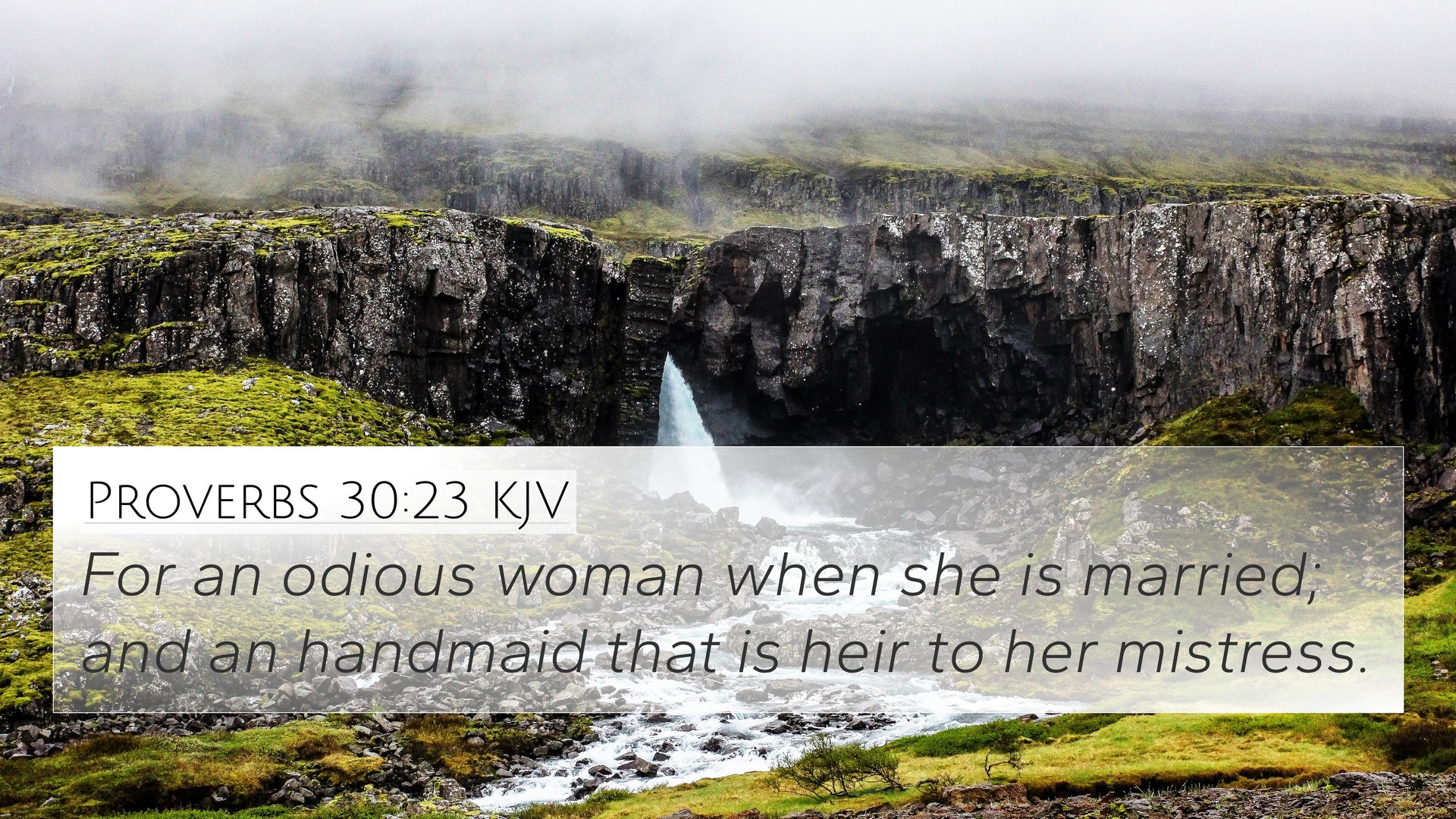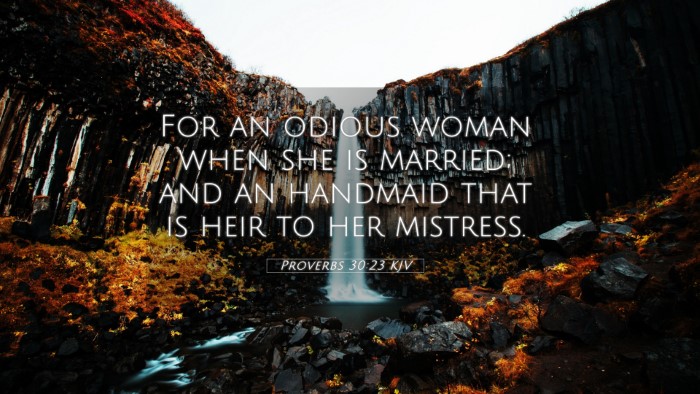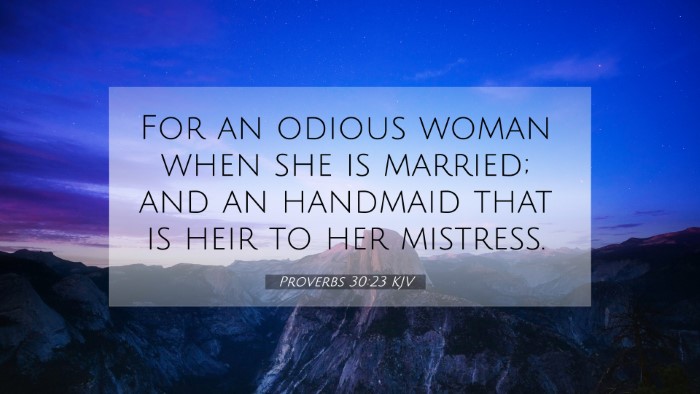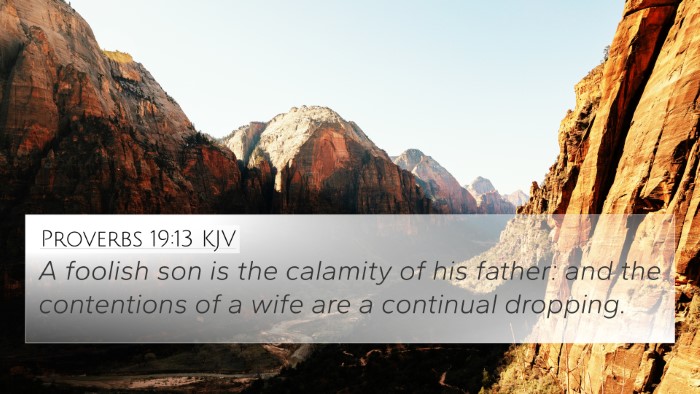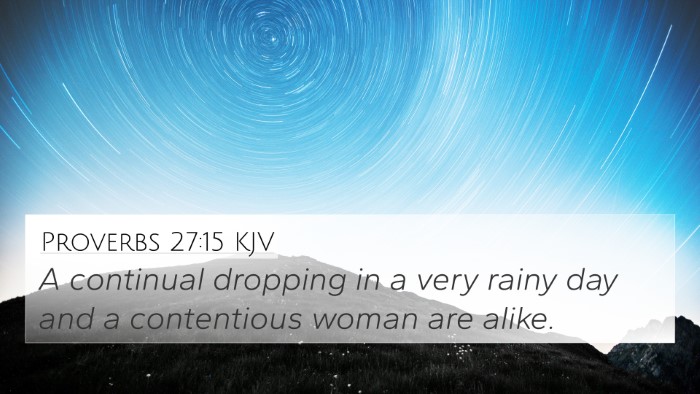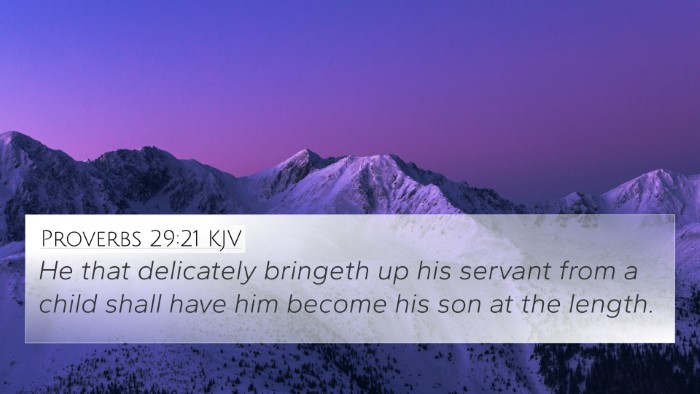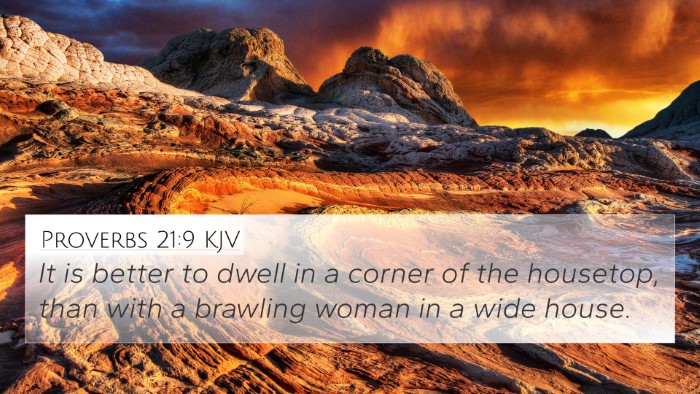Understanding Proverbs 30:23
Proverbs 30:23 states: "For an odious woman when she is married; and a handmaid that is heir to her mistress." This verse highlights various social dynamics and relationships within the context of marital and societal roles. To interpret its meaning more deeply, we can draw insights from notable public domain commentaries, including those by Matthew Henry, Albert Barnes, and Adam Clarke.
Verse Context and Meaning
This verse appears within a series of observations made by Agur, the author of Proverbs 30. By contrasting different relational scenarios, it aims to elucidate the complexities of human behavior, particularly in the context of women’s roles in relationships.
- Matthew Henry Commentary:
Henry suggests that the "odious woman" represents traits that lead to conflict, especially in a marital setting. He interprets that a woman known for her disagreeable nature can be particularly burdensome once she enters into matrimony, creating disharmony in the household.
- Albert Barnes Commentary:
Barnes points out that this proverb illustrates the misfortunes that arise when relational roles become distorted. The reference to a "handmaid" who becomes an "heir" to her mistress alludes to situations where societal norms are upended, resulting in bitterness and rivalry.
- Adam Clarke Commentary:
Clarke expands on the layered meanings of this passage, indicating how it reflects the broader themes of jealousy and envy that can emerge in intimate relationships, especially concerning women's roles and societal expectations.
Bible Cross-References
To draw a better understanding of Proverbs 30:23, we can explore several related Bible verses:
- Proverbs 21:9: "It is better to dwell in a corner of the housetop than with a brawling woman in a wide house."
- Proverbs 19:13: "A foolish son is the calamity of his father: and the contentions of a wife are a continual dropping."
- Ecclesiastes 7:26: "And I find more bitter than death the woman whose heart is snares and nets, and her hands as bands."
- 1 Timothy 2:12: "But I suffer not a woman to teach, nor to usurp authority over the man, but to be in silence."
- Genesis 30:9-13: The story of Leah and Rachel reflects jealousy and rivalry among women regarding marriage and children.
- Galatians 3:28: "There is neither Jew nor Greek, neither bond nor free, neither male nor female: for ye are all one in Christ Jesus."
- James 3:16: "For where envying and strife is, there is confusion and every evil work."
Thematic Connections
These cross-references demonstrate how Proverbs 30:23 links to various themes within scripture:
- Relationships and Marital Conflicts: Many verses in Proverbs and Ecclesiastes address the challenges and pitfalls within intimate partnerships.
- Women's Roles: Various scriptures discuss the position and responsibilities of women, reflecting the ongoing dialogues about gender roles in biblical times.
- Rivalry and Bitterness: Several verses indicate how envy can corrupt relationships, particularly among women.
Cross-Referencing Biblical Texts
Identifying connections between these verses encourages a comparative Bible verse analysis that can enhance understanding and application of wisdom literature. By utilizing Bible concordance tools and cross-reference guides, readers can develop a deeper grasp of scripture's layered meanings.
Tools for Bible Cross-Referencing
Utilizing a Bible cross-reference system allows readers to explore these interconnections and better understand each verse's context. Ways to engage include:
- Cross-Reference Bible Study: Focusing on how verses interact with and illuminate one another.
- Bible Chain References: Following themes through chains of related verses to see deeper meanings.
- Comprehensive Bible Cross-Reference Materials: Employing resources that offer extensive lists of connections.
Inter-Biblical Dialogue
Engaging in an inter-Biblical dialogue enables one to discuss the direct implications of such scriptures across both Old and New Testaments. Thematic Bible verse connections show how consistent biblical themes—like relationships, jealousy, and societal roles—reinforce the wisdom inherent in Proverbs 30:23.
Conclusion
In summary, Proverbs 30:23 serves as a profound reminder of the complexities of relationships and the resulting emotional turmoil caused by unharmonious traits. By cross-referencing these verses and engaging in comparative studies, believers can uncover deeper truths about both historical and contemporary relational dynamics.
